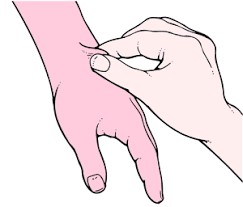A hospice nurse is visiting with the son of a client who has terminal cancer.
The son reports sleeping very little during the past week due to caring for his mother.
Which of the following responses should the nurse make?
I can give you information about respite care if you are interested
You should consider taking a sleeping pill before bed each night
I am sure you’re doing a great job taking care of your mother
It is always difficult caring for someone who is terminally ill
The Correct Answer is A
The correct answer is choice A. “I can give you information about respite care if you are interested.” Respite care is a service that provides short-term inpatient care for terminally-ill patients at a professional care facility, such as a hospital, hospice inpatient care facility, or nursing home. It is meant to relieve caregiver stress and offer them rest and time away from caregiving duties. Respite care is covered by Medicare for up to five consecutive days and no more than one respite period in a single billing period.
The nurse should offer this option to the son who is experiencing sleep deprivation due to caring for his mother.
Choice B is wrong because it suggests that the son should rely on medication to cope with his situation, which may not be appropriate or effective.
Sleeping pills may have side effects or interactions with other drugs, and they do not address the underlying cause of the son’s stress and fatigue.
Choice C is wrong because it does not acknowledge the son’s need for support or assistance.
It may sound like an empty compliment or a dismissal of the son’s concerns.
The nurse should express empathy and compassion, but also provide information and resources that can help the son.
Choice D is wrong because it does not offer any solution or guidance to the son.
It may also sound like a cliché or a generalization that does not reflect the son’s unique experience.
The nurse should avoid making assumptions or judgments about the son’s feelings or situation, and instead focus on his needs and preferences.
Nursing Test Bank
Naxlex Comprehensive Predictor Exams
Related Questions
Correct Answer is D
Explanation
The correct answer is D. Remind the client to use the incentive spirometer.
Choice A rationale:
Observing the position of the suspended weight is beyond the scope of practice for assistive personnel (AP). This task requires assessment skills to ensure proper alignment and functioning of the traction system, which is the responsibility of the nurse.
Choice B rationale:
Checking the client’s pedal pulse on the right leg involves assessment and clinical judgment to evaluate perfusion and detect potential complications such as impaired circulation. This is not a task that can be delegated to AP.
Choice C rationale:
Asking the client to describe her pain requires assessment and interpretation of subjective data, which falls under the nurse's scope of practice. Pain assessment is a critical nursing function.
Choice D rationale:
Reminding the client to use the incentive spirometer is a non-assessment task that involves reinforcing previously taught instructions. This is appropriate to delegate to assistive personnel, as it does not require clinical judgment.
Correct Answer is D
Explanation
Choice A reason
Abdomen area is not appropriate: Assessing skin turgor on the abdomen is not commonly performed. The abdomen may not be the most accurate site for assessing skin turgor, especially in older adults, as it can be influenced by factors such as body fat distribution.
Choice B reason:
Shoulder are is not appropriate: The shoulder is not a typical site for assessing skin turgor. It is generally not used for this purpose, as it may not provide reliable results
Choice C reason:
Stomach is not the correct answer.: Assessing skin turgor on the stomach is also not commonly performed. The abdomen or stomach may not be the most accurate site for assessing skin turgor, especially in older adults.
Choice D reason
When assessing skin turgor in an older adult client, the nurse should lift the skin on the neck to evaluate its elasticity and hydration status. Skin turgor is a measure of skin's elasticity and is commonly used as an indicator of hydration in both adults and older adults.
To assess skin turgor, the nurse will gently pinch a small amount of skin on the back of the client's hand or the front of the chest (sternum). However, since the options listed do not include these areas, the closest alternative for an older adult would be the neck.

Whether you are a student looking to ace your exams or a practicing nurse seeking to enhance your expertise , our nursing education contents will empower you with the confidence and competence to make a difference in the lives of patients and become a respected leader in the healthcare field.
Visit Naxlex, invest in your future and unlock endless possibilities with our unparalleled nursing education contents today
Report Wrong Answer on the Current Question
Do you disagree with the answer? If yes, what is your expected answer? Explain.
Kindly be descriptive with the issue you are facing.
